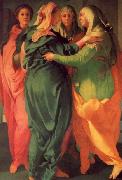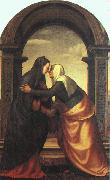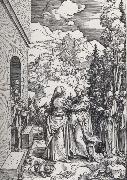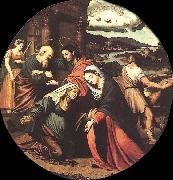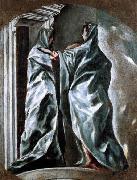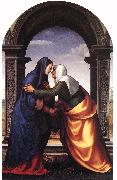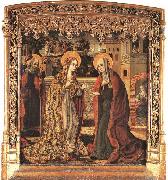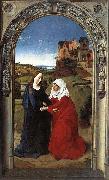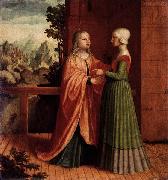Wholesale Oil Painting No Minimum |
|||||||||||
|
|
|||||||||||

|
|||||||||||
|
|
|
||||||||
Joachim Patenier1480-1525 Flemish Joachim Patenier Galleries was a Flemish Northern Renaissance history and landscape painter. He was probably the uncle of Herri met de Bles, with whom he helped establish a distinct style of northern Renaissance landscapes. |
||||||||
|
|
||||||||
The Visitation
The Visitation Painting ID:: 1593 |
1530/32 Pieve di San Michele, Carmignano 1530/32 Pieve di San Michele, Carmignano |
|||||||
|
|
||||||||
Albertinelli, MariottoItalian Early Renaissance Painter, 1474-1515] Studied under Cosimo Rosselli. Albertinelli's students included Pontormo . Italian painter. Albertinelli's contribution to the Florentine High Renaissance was inspired by the work of FRA BARTOLOMMEO, and the two artists worked together in a partnership, their paintings appearing to be the product of a single hand. Albertinelli, however, always retained artistic independence, as is revealed in certain paintings that are eccentrically archaic and in others that show a preference for conventions more typical of the early Renaissance. |
||||||||
|
|
||||||||
|
|
The Visitation
The Visitation Painting ID:: 10741 |
1503, oil on wood, Galleria degli Uffizi, Florence 1503, oil on wood, Galleria degli Uffizi, Florence |
||||||
|
|
||||||||
Vleughels NicolasFrench , b Paris, 6 Dec 1668; d Rome, 11 Dec 1737 |
||||||||
|
|
||||||||
|
|
The Visitation
The Visitation Painting ID:: 29134 |
mk65
ca.1729
Oil on panel
14x10 1/2"
mk65 ca.1729 Oil on panel 14x10 1/2" |
||||||
|
|
||||||||
Albrecht Durerb.May 21, 1471, Imperial Free City of Nernberg [Germany] d.April 6, 1528, Nernberg Albrecht Durer (May 21, 1471 ?C April 6, 1528) was a German painter, printmaker and theorist from Nuremberg. His still-famous works include the Apocalypse woodcuts, Knight, Death, and the Devil (1513), Saint Jerome in his Study (1514) and Melencolia I (1514), which has been the subject of extensive analysis and interpretation. His watercolours mark him as one of the first European landscape artists, while his ambitious woodcuts revolutionized the potential of that medium. D??rer introduction of classical motifs into Northern art, through his knowledge of Italian artists and German humanists, have secured his reputation as one of the most important figures of the Northern Renaissance. This is reinforced by his theoretical treatise which involve principles of mathematics, perspective and ideal proportions. His prints established his reputation across Europe when he was still in his twenties, and he has been conventionally regarded as the greatest artist of the Renaissance in Northern Europe ever since. |
||||||||
|
|
||||||||
|
|
The Visitation
The Visitation Painting ID:: 42434 |
mk168
300x211mm
mk168 300x211mm |
||||||
|
|
||||||||
Juan Vicente MasipSpanish Painter, ca.1475-1545 |
||||||||
|
|
||||||||
|
|
The Visitation
The Visitation Painting ID:: 52629 |
60 cm Museo del Prado, Madrid During the second third of the sixteenth century 60 cm Museo del Prado, Madrid During the second third of the sixteenth century |
||||||
|
|
||||||||
El GrecoGreek-born Spanish Mannerist Painter, 1541-1614 Considered a representative of late Renaissance Spanish art, El Greco was actually born in Greece, on the island of Crete. After studying in Venice under Titian, El Greco settled in Toledo, Spain in 1577. At the time he was wildly popular, his emotionally religious paintings being just the ticket for the hometown of the Spanish Inquisition. After his death his work was largely ignored until the beginning of the 20th century; now he considered one of the inspired geniuses of Western art. His distinctive style features bold shapes and colors, with elongated and slightly distorted figures. In Toledo El Greco was in constant demand and liked living large: he maintained a private orchestra to accompany his meals. |
||||||||
|
|
||||||||
|
|
The Visitation
The Visitation Painting ID:: 52660 |
1610-13 Oil on canvas, 96 x 72,4 cm 1610-13 Oil on canvas, 96 x 72,4 cm |
||||||
|
|
||||||||
Mariotto Albertinelli(October 13, 1474 - November 5, 1515) was a High Renaissance Italian painter of the Florentine school, closely involved with Fra Bartolomeo and influenced by Raphael. He was born in Florence. Already as a 12-year old boy, he became a pupil of Cosimo Rosselli, and a fellow-pupil with Fra Bartolomeo with whom he formed such an intimate brotherly rapport that in 1494 the two started their own studio in Florence. Vasari's opinion was that Mariotto was not so well grounded in drawing as Bartolomeo, and he tells that, to improve his hand he had taken to drawing the antiquities in the Medici garden, where he was encouraged by Madonna Alfonsina, the mother of Duke Lorenzo II de' Medici. When the Medici were temporarily banished in 1494, he returned to his friend, whose manner he copied so assiduously, according to Vasari, that his works were taken for Baccio's. When, in the wake of Savonarola's morality campaign, Baccio joined the Dominican order as Fra Bartolomeo in 1500 and gave up painting, Albertinelli, beside himself with the loss, would have joined him; but, spurred by his success in completing an unfinished Last Judgment of Bartolomeo's, he resolved to carry on alone. Among his many students were Jacopo da Pontormo, Innocenzo di Pietro Francucci da Imola and Giuliano Bugiardini. Mariotto was a most restless person and carnal in the affairs of love and apt to the art of living, and, taking a dislike to the studies and brain-wracking necessary to painting, being also often stung by the tongues of other painters, as is their way, he resolved to give himself to a less laborious and more jovial profession, and so opened the most lovely hostelry outside the Porta San Gallo, and at the sign of the Dragon at the Ponte Vecchio a tavern and inn. This life he led for many months, saying that he had taken up an art that was without muscles, foreshortening or perspective and, better still, without faultfinding, and that the art that he had given up imitated flesh and blood, but this one created flesh and blood; in this if you had good wine you heard yourself praised, but in that every day you were blamed. But at last the low life became an annoyance to him, and, filled with remorse, he returned to painting. |
||||||||
|
|
||||||||
|
|
The Visitation
The Visitation Painting ID:: 58183 |
The Visitation, painted for the Congregazione di San Martino 1503, Mariotto Alberti's masterpiece (Galleria degli Uffizi, Florence). The Visitation, painted for the Congregazione di San Martino 1503, Mariotto Alberti's masterpiece (Galleria degli Uffizi, Florence). |
||||||
|
|
||||||||
|
|
||||||||
|
|
The Visitation
The Visitation Painting ID:: 65256 |
1480-1500 Panel, 126 x 155 cm Museo del Prado, Madrid The artist of the panel is referred to as the Master of Perea. Artist: UNKNOWN MASTER, Spanish , The Visitation , 1451-1500 , Spanish , painting , religious 1480-1500 Panel, 126 x 155 cm Museo del Prado, Madrid The artist of the panel is referred to as the Master of Perea. Artist: UNKNOWN MASTER, Spanish , The Visitation , 1451-1500 , Spanish , painting , religious |
||||||
|
|
||||||||
Paolo Veronese1528-1588 Paolo Veronese Galleries Italian painter and draughtsman. With Titian and Tintoretto he makes up the triumvirate of great painters of the late Renaissance in Venice. He is known as a supreme colourist and for his illusionistic decorations in both fresco and oil. His large paintings of biblical feasts executed for the refectories of monasteries in Venice and Verona are especially celebrated. He also produced many altarpieces, history and mythological paintings and portraits. His compositional sketches in pen, ink and wash, figure studies in chalk, and chiaroscuro modelli and ricordi form a significant body of drawings. He headed a family workshop that remained active after his death. |
||||||||
|
|
||||||||
|
|
the visitation
the visitation Painting ID:: 69060 |
birmingham, barber institute. 272x152.5cm
se birmingham, barber institute. 272x152.5cm se |
||||||
|
|
||||||||
Dieric Bouts1420-1475 Flemish Dieric Bouts Locations Dirk Bouts whose real name was Theodorik Romboutszoon, was probably born in Haarlem, where he may have studied under the painter Albert van Ouwater. Sometime before 1450 Bouts took up residence in the Flemish city of Louvain. His name appeared in the records of Louvain in 1457 and again in 1468, when he was appointed "city painter." It is likely that Bouts spent some time in Bruges, as his earliest work, the Infancy Altarpiece shows the distinct and strong influence of Petrus Christus, the leading master of that city after the death of Jan van Eyck. The slightly later Deposition Altarpiece (ca. 1450) displays strong connections with the style of Rogier van der Weyden in both the figure types and the composition. About 1460, the period of the Entombment in London, the early, formative influence of Petrus Christus had been almost totally displaced by that of Rogier, though Bouts personal vision began to emerge in the fluid and continuous landscape background. The great Last Supper Altarpiece (1464-1467) marks the high point of Bouts career. In this solemn and dignified masterpiece the painter achieved spiritual grandeur in the context of convincing physical reality. The central panel of the altarpiece is the most emphatically significant treatment of the theme of the Last Supper in Northern European art. The wings, which contain Old Testament prefigurations of the central theme, are freer and more loosely organized. Eschewing the symmetry and rigid axial construction of the main panel, Bouts produced rhythmic foreground compositions in combination with fluid and dramatic spatial recessions. In 1468 Bouts was commissioned to paint four panels on the subject of justice for the Town Hall of Louvain. At the painter death in 1475 only two of the paintings had been completed; they are among the most remarkable productions of his career. The unusual subjects, taken from the chronicles of a 12th-century historian, concern the wrongful execution by Emperor Otto III of one of his counts and the subsequent vindication of the nobleman by his wife. The finer of the panels represents the dramatic trial by fire which the wife was obliged to undergo to prove her husband innocence. Rich draperies and sumptuous colors are applied to tall angular forms to create a work of rare formal elegance and high decorative appeal. In order to dignify the event, however, the artist has employed restrained gestures and expressions as well as a completely rationalized spatial setting. As in the Last Supper Altarpiece, a sense of solemn and hieratic importance is expressed by means of an austere and rigid geometry in the construction of both persons and places. The late productions of Bouts workshop, such as the well-known Pearl of Brabant Altarpiece, are characterized by the close collaboration of the painter two sons, Dirk the Younger (1448-1491) and Aelbrecht (1455/1460-1549). In the paintings of his less gifted sons, the master distinctive figure style was appreciably altered, though Dirk the Younger appears to have retained much of his father sensitivity to the landscape. In addition to his innovations in the depiction of landscape, Bouts made a substantial contribution to the development of the portrait. His Portrait of a Man (1462) localizes the sitter in an enlarged architectural setting while permitting the interior space to merge with the exterior through an open window. For the first time in Northern painting a common bond was forged between a particularized individual and the universal world of nature. |
||||||||
|
|
||||||||
|
|
The Visitation
The Visitation Painting ID:: 87592 |
Date c. 1445(1445)
Medium Oil on wood
Dimensions Height: 80 cm (31.5 in). Width: 56 cm (22 in).
cjr Date c. 1445(1445) Medium Oil on wood Dimensions Height: 80 cm (31.5 in). Width: 56 cm (22 in). cjr |
||||||
|
|
||||||||
Master of Ab MonogramMASTER of AB Monogram. German painter (active 1530s in Saxony |
||||||||
|
|
||||||||
|
|
The Visitation
The Visitation Painting ID:: 89791 |
1530(1530)
Medium oil on linden
Dimensions Height: 42 cm (16.5 in). Width: 39 cm (15.4 in).
cyf 1530(1530) Medium oil on linden Dimensions Height: 42 cm (16.5 in). Width: 39 cm (15.4 in). cyf |
||||||
|
|
||||||||
|
Master of Ab Monogram MASTER of AB Monogram. German painter (active 1530s in Saxony The Visitation 1530(1530) Medium oil on linden Dimensions Height: 42 cm (16.5 in). Width: 39 cm (15.4 in). cyf |
||||||||
|
|
||||||||
|
Prev Next
|
||||||||
|
|
||||||||
|
Related Paintings to Master of Ab Monogram :. |
||||||||
|
|
||||||||
|
CONTACT US |
